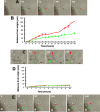Neuroblast division during migration toward the ischemic striatum: a study of dynamic migratory and proliferative characteristics of neuroblasts from the subventricular zone
- PMID: 17376977
- PMCID: PMC6672487
- DOI: 10.1523/JNEUROSCI.4969-06.2007
Neuroblast division during migration toward the ischemic striatum: a study of dynamic migratory and proliferative characteristics of neuroblasts from the subventricular zone
Abstract
Ischemic stroke induces neurogenesis in the subventricular zone (SVZ), and newly generated neurons in the SVZ migrate toward the ischemic boundary. However, the characteristics of migrating SVZ cells have not been investigated after stroke. Using time-lapse imaging in both SVZ cells and organotypic brain slice cultures, we measured the dynamics of SVZ cell division and migration of adult rats subjected to stroke. In normal brain slices, SVZ cells primarily migrated dorsally and ventrally along the lateral ventricular surface. However, in stroke brain slices, SVZ cells migrated laterally toward the striatal ischemic boundary. Cultured stroke-derived SVZ cells exhibited a significant (p < 0.01) increase in the migration distance (212 +/- 21 microm) compared with the nonstroke-derived SVZ cells (97 +/- 12 microm). Migrating stroke-derived SVZ cells spent significantly (p = 0.01) less time in cytokinesis (0.63 +/- 0.04 h) compared with the time (1.09 +/- 0.09 h) for nonstroke-derived SVZ cells. Newborn cells with a single leading process exhibited fast migration (7.2 +/- 0.8 microm/h), and cells with multiple processes showed stationary migration (3.6 +/- 0.8 microm/h). Stroke SVZ daughter cells further divided during their migration. The morphology of doublecortin (DCX)-positive cells in fixed brain sections resembled those observed in cultured newborn cells, and the DCX-positive cells proliferated in the ischemic striatum. Collectively, the present study suggests that stroke promotes cytokinesis of migrating neuroblasts, and these cells migrate toward the ischemic striatum with distinct migratory behaviors and retain the capacity for cell division during migration.
Figures





Similar articles
-
Patterns and dynamics of subventricular zone neuroblast migration in the ischemic striatum of the adult mouse.J Cereb Blood Flow Metab. 2009 Jul;29(7):1240-50. doi: 10.1038/jcbfm.2009.55. Epub 2009 May 13. J Cereb Blood Flow Metab. 2009. PMID: 19436318 Free PMC article.
-
Subventricular zone-derived neural progenitor cells migrate along a blood vessel scaffold toward the post-stroke striatum.Stem Cells. 2010 Mar 31;28(3):545-54. doi: 10.1002/stem.306. Stem Cells. 2010. PMID: 20073084
-
Activated neural stem cells contribute to stroke-induced neurogenesis and neuroblast migration toward the infarct boundary in adult rats.J Cereb Blood Flow Metab. 2004 Apr;24(4):441-8. doi: 10.1097/00004647-200404000-00009. J Cereb Blood Flow Metab. 2004. PMID: 15087713
-
Gene profiles within the adult subventricular zone niche: proliferation, differentiation and migration of neural progenitor cells in the ischemic brain.Curr Mol Med. 2007 Aug;7(5):459-62. doi: 10.2174/156652407781387136. Curr Mol Med. 2007. PMID: 17691960 Review.
-
Architecture and cell types of the adult subventricular zone: in search of the stem cells.J Neurobiol. 1998 Aug;36(2):234-48. doi: 10.1002/(sici)1097-4695(199808)36:2<234::aid-neu10>3.0.co;2-e. J Neurobiol. 1998. PMID: 9712307 Review.
Cited by
-
Endocannabinoids regulate the migration of subventricular zone-derived neuroblasts in the postnatal brain.J Neurosci. 2011 Mar 16;31(11):4000-11. doi: 10.1523/JNEUROSCI.5483-10.2011. J Neurosci. 2011. PMID: 21411643 Free PMC article.
-
Mechanisms and Functional Significance of Stroke-Induced Neurogenesis.Front Neurosci. 2015 Dec 8;9:458. doi: 10.3389/fnins.2015.00458. eCollection 2015. Front Neurosci. 2015. PMID: 26696816 Free PMC article. Review.
-
Removal of polysialic acid triggers dispersion of subventricularly derived neuroblasts into surrounding CNS tissues.J Neurosci. 2010 Mar 17;30(11):3995-4003. doi: 10.1523/JNEUROSCI.4382-09.2010. J Neurosci. 2010. PMID: 20237270 Free PMC article.
-
Angiogenesis, neurogenesis and brain recovery of function following injury.Curr Opin Investig Drugs. 2010 Mar;11(3):298-308. Curr Opin Investig Drugs. 2010. PMID: 20178043 Free PMC article. Review.
-
Human neural progenitor cell engraftment increases neurogenesis and microglial recruitment in the brain of rats with stroke.PLoS One. 2012;7(11):e50444. doi: 10.1371/journal.pone.0050444. Epub 2012 Nov 21. PLoS One. 2012. PMID: 23185625 Free PMC article.
References
-
- Arvidsson A, Collin T, Kirik D, Kokaia Z, Lindvall O. Neuronal replacement from endogenous precursors in the adult brain after stroke. Nat Med. 2002;8:963–970. - PubMed
-
- Feng Y, Walsh CA. Protein-protein interactions, cytoskeletal regulation and neuronal migration. Nat Rev Neurosci. 2001;2:408–416. - PubMed
Publication types
MeSH terms
Grants and funding
LinkOut - more resources
Full Text Sources
